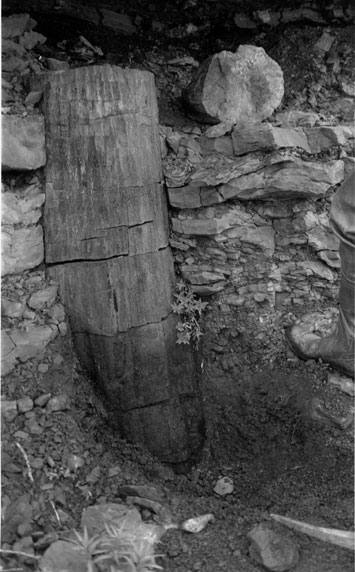Locality 96-19. 69° 16' 06" N 162° 47' 24" W
Corwin Formation
Specimen: 96 RAS 109, 110a, 110b
Description. Tree stump 35 - 40 cm diameter, preserved vertical to bedding surrounded by gray/brown silty mudstone with ironstone nodules, lumpy texture, no obvious rooting. The bark of the tree is represented by a coaly layer (96 RAS 109). The ring structure and some cellular detail is apparent in the cross section of the wood (96 RAS 110a, 96 RAS 110b) taken from near the top of the exposed trunk). The bottom of the stump was excavated to a depth of approximately 1 m but the root flair was not reached. The tree was possibly rooted in a dark gray shale that lateral exposures showed underlay the silty mudstone. Ironstone nodules within this shale contained large Pityophyllum and large Podozamites leaves. The silty mudstone became darker gray and more obviously laminated in its upper part before being covered by light gray fine sandstone. The top of the stump was abraded and protruded into a hollow in the underside of this sandstone.
Interpretation. An in situ tree (see below and below right) rooted in Nanushuk floodplain soils inundated by two episodes of crevasse splay deposition, the second being more proximal to the channel than the first. The period between crevasse splay events was sufficient for partial rotting of the exposed portion of the buried stump to take place. This partly rotted portion of the stump was abraded by the second sand inundation.
Right: The well preserved standing conifer tree base that was the source of samples 96 RAS 109 and 110.
Below: The same tree with the base partly excavated.

|



